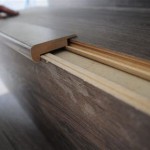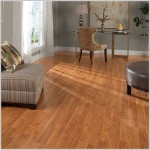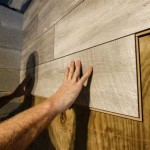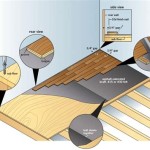Bamboo Bathroom Flooring: A Comprehensive Guide
Bamboo flooring has emerged as a popular choice for homeowners seeking sustainable, durable, and aesthetically pleasing alternatives to traditional hardwood. While often associated with living areas and bedrooms, bamboo is also finding its place in bathrooms. This article will explore the suitability of bamboo for bathroom flooring, considering its advantages, disadvantages, different types, installation considerations, and maintenance requirements. Understanding these factors is crucial for making an informed decision about whether bamboo flooring is the right choice for a specific bathroom environment.
The allure of bamboo flooring stems from its rapid renewability. Bamboo, a type of grass, matures much faster than hardwood trees, making it a more environmentally responsible option. Its natural beauty, characterized by a distinctive grain pattern, adds a touch of elegance and warmth to any space. However, the bathroom presents unique challenges due to its high humidity levels and potential for water exposure. Therefore, careful consideration and proper precautions are necessary to ensure the longevity and performance of bamboo flooring in this demanding environment.
Understanding Bamboo Flooring Options
Not all bamboo flooring is created equal. Several types are available, each with varying characteristics that impact its suitability for bathroom use. The primary distinctions lie in the manufacturing process, resulting in differences in hardness, durability, and water resistance.
Strand-woven bamboo: This is arguably the most durable type of bamboo flooring. It is created by shredding bamboo stalks into strands, which are then compressed and bonded together under high pressure with adhesives. This process results in a material significantly harder than traditional hardwood, making it more resistant to dents and scratches. Its density also contributes to improved water resistance compared to other bamboo types.
Horizontal bamboo: This type is characterized by the visible knuckles of the bamboo stalks running horizontally across the planks. It is made by bonding the bamboo strips together side by side. While aesthetically pleasing, horizontal bamboo is generally softer than strand-woven bamboo and thus less durable and less water-resistant.
Vertical bamboo: In this type, the bamboo strips are oriented vertically, creating a more linear and uniform appearance. Similar to horizontal bamboo, vertical bamboo is not as hard or water-resistant as strand-woven bamboo.
Beyond these main classifications, the quality of the adhesive used in manufacturing plays a crucial role. Opting for bamboo flooring that uses low-VOC (volatile organic compound) adhesives is essential for maintaining good indoor air quality, particularly in a confined space like a bathroom.
Advantages of Bamboo Flooring in Bathrooms
When properly selected and installed, bamboo flooring offers several advantages for bathroom applications:
Aesthetic Appeal: Bamboo provides a warm and inviting aesthetic that complements a variety of bathroom styles. Its natural grain patterns add visual interest and create a spa-like ambiance. The availability of different stain colors and finishes allows homeowners to customize the look to match their existing decor.
Sustainability: As a rapidly renewable resource, bamboo flooring aligns with eco-conscious design principles. Choosing bamboo can reduce the demand for slow-growing hardwoods, contributing to forest conservation efforts.
Durability: Strand-woven bamboo, in particular, offers excellent durability, making it resistant to dents, scratches, and wear and tear. This is crucial in a high-traffic area like the bathroom.
Water Resistance (Relative): While not completely waterproof, bamboo possesses a degree of water resistance, especially when properly sealed. This is particularly true for strand-woven varieties and those treated with water-resistant finishes.
Comfort: Bamboo flooring provides a comfortable surface underfoot, feeling warmer and softer than tile or stone. This can enhance the overall bathroom experience, especially during colder months.
Ease of Cleaning: Bamboo flooring is relatively easy to clean and maintain. Regular sweeping and occasional damp mopping are typically sufficient to keep it looking its best. Mild detergents can be used to remove stubborn stains.
Disadvantages and Considerations for Bathroom Use
Despite its advantages, bamboo flooring is not without its drawbacks when used in bathrooms. Careful consideration of these factors is essential before making a decision:
Water Sensitivity: While more water-resistant than some hardwoods, bamboo is still susceptible to water damage if exposed to excessive moisture. Standing water or leaks can cause warping, swelling, and discoloration. Proper sealing and ventilation are crucial to mitigate this risk.
Humidity Concerns: Bathrooms are inherently humid environments. Prolonged exposure to high humidity can affect the stability of bamboo flooring, potentially leading to expansion and contraction. This can result in gaps between planks or buckling. A well-ventilated bathroom is essential.
Cost: The cost of bamboo flooring can vary depending on the type, quality, and installation method. High-quality strand-woven bamboo can be comparable in price to some hardwood options, potentially making it a more significant investment.
Installation Complexity: Proper installation is critical for the long-term performance of bamboo flooring in a bathroom. Inadequate subfloor preparation or improper sealing can compromise its water resistance and durability. Professional installation is often recommended.
Potential for Mold and Mildew: In moist environments, bamboo is susceptible to mold and mildew growth if not properly maintained. Regular cleaning and adequate ventilation are essential to prevent this problem.
Scratch Sensitivity (Certain Types): While strand-woven bamboo is highly scratch-resistant, other types, such as horizontal and vertical bamboo, are more prone to scratches and dents. Choosing the right type for the expected level of traffic and potential for abrasion is important.
Installation and Maintenance Best Practices
To maximize the lifespan and performance of bamboo flooring in a bathroom, meticulous installation and diligent maintenance are paramount.
Subfloor Preparation: A level, clean, and dry subfloor is essential. Any imperfections or moisture issues must be addressed before installation. Using a moisture barrier underlayment is highly recommended to protect the bamboo from moisture rising from the subfloor.
Acclimation: Allow the bamboo flooring to acclimate to the bathroom environment for several days before installation. This allows the material to adjust to the local temperature and humidity levels, minimizing expansion and contraction after installation.
Sealing: Apply a high-quality sealant specifically designed for bamboo flooring. Pay particular attention to sealing the edges of the planks to prevent water penetration. Regular resealing may be necessary to maintain optimal water resistance.
Ventilation: Ensure adequate ventilation in the bathroom. Use exhaust fans during and after showers and baths to remove excess moisture. This will help prevent humidity buildup and reduce the risk of water damage.
Cleaning: Clean spills immediately to prevent water from seeping into the seams. Use a damp mop with a mild detergent to clean the floor regularly. Avoid using excessive water or harsh chemicals, as these can damage the finish.
Preventative Measures: Use rugs or mats in high-traffic areas and near sinks and showers to protect the flooring from water and wear. Consider using furniture pads under heavy objects to prevent scratches and dents.
Regular Inspection: Regularly inspect the flooring for signs of water damage, such as warping, swelling, or discoloration. Address any issues promptly to prevent them from escalating.
By following these installation and maintenance best practices, homeowners can significantly extend the life of their bamboo flooring and enjoy its beauty and benefits for years to come. Choosing the right type of bamboo, ensuring proper installation, and implementing a consistent maintenance routine are all crucial for success in a bathroom environment.

Bamboo Flooring For Bathrooms 2024 Trends And Styles

Is Bamboo Flooring Suitable For Bathrooms

Bamboo Flooring For Bathrooms 2024 Trends And Styles

Aquaseal 7mm W Pad Toffee Distressed Water Resistant Strand Engineered Bamboo Flooring 5 13 In Wide Ll

Can I Install Bamboo Flooring In My Bathroom The Company

Bamboo Bathroom Tile Ideal Flooring For Bath Garden Swimming Pool Sauna Room Waterproof

35 Bamboo Flooring Ideas With Pros And Cons Digsdigs

Bamboo Flooring For Bathrooms 2024 Trends And Styles

Bamboo Flooring For Bathrooms 2024 Trends And Styles

All You Need To Know About Bamboo Flooring Pros And Cons Engineered Wood Floors Wide Plank
Related Posts








